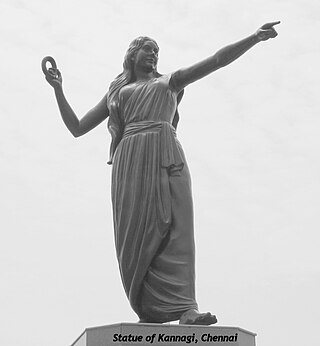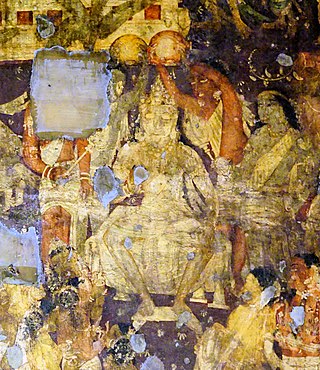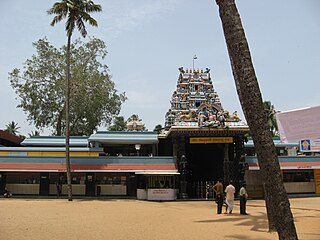
Kannagi, sometimes spelled Kannaki, is a legendary Tamil woman who forms the central character of the Tamil epic Cilappatikaram. Kannagi is described as a chaste woman who stays with her husband despite his adultery, their attempt to rebuild their marriage after her unrepentant husband had lost everything, how he is framed then punished without the due checks and processes of justice. Kannagi proves and protests the injustice, then curses the king and city of Madurai leading to the death of the unjust Pandyan King of Madurai, who had wrongfully put her husband Kovalan to death. The society that had made her suffer, suffers in retribution as the city Madurai is burnt to the ground because of her curse. In Tamil folklore, Kannagi has been deified as the symbol – sometimes as goddess – of chastity, with sculptures or reliefs in Hindu temples iconographically reminding the visitor of her breaking her anklet or tearing her bleeding breast and throwing it at the city.

Cilappatikāram, also referred to as Silappathikaram or Silappatikaram, is the earliest Tamil epic. It is a poem of 5,730 lines in almost entirely akaval (aciriyam) meter. The epic is a tragic love story of an ordinary couple, Kannaki and her husband Kovalan. The Cilappatikaram has more ancient roots in the Tamil bardic tradition, as Kannaki and other characters of the story are mentioned or alluded to in the Sangam literature such as in the Naṟṟiṇai and later texts such as the Kovalam Katai. It is attributed to a prince-turned-monk Iḷaṅkō Aṭikaḷ, and was probably composed in the 2nd century CE.

Prince Vijaya was a legendary king of Tambapanni, based in modern day Sri Lanka. His reign was first mentioned in Mahāvaṃsa. He is said to have came to Sri Lanka with a seven hundred followers after being banished from Sinhapura. However, there is no archaeological evidence of this.

Munneswaram temple is an important regional Hindu temple complex in Sri Lanka. It has been in existence at least since 1000 CE although myths surrounding the temple associate it with the popular Indian epic Ramayana, and its legendary hero-king Rama. The temple is one of the ancient Pancha Ishwarams dedicated to Shiva in the region.
Pattini, is considered a guardian deity of Sri Lanka in Sri Lankan Buddhism and Sinhalese folklore. She is also worshipped by Sri Lankan Tamil Hindus by the name of Kannaki Amman.
Gajabahu I, also known as Gajabahuka Gamani, was a Sinhalese king of Rajarata in Sri Lanka. He is renowned for his military prowess, religious benefactions, extensive involvement in South Indian politics, and for possibly introducing the cult of the goddess Pattini to Sri Lanka. The primary source for his reign is the Mahavamsa, though he is also the only early Sri Lankan king to be extensively mentioned in the Chera Cilappatikaram.

Kovalan is a central character in Ilango Adigal's Silappatikaram, one of the ancient Tamil epics.

Tamil mythology refers to the folklore and traditions that are a part of the wider Dravidian pantheon, originating from the Tamil people. This body of mythology is a fusion of elements from Dravidian culture and the parent Indus Valley culture, both of which have been syncretised with mainstream Hinduism.

Madhavi is a central character in the Silapathikaram, one of the epics in Tamil literature. Silapathikaram is the first Kappiyam (epic) among the five in Tamil literature. It belongs to the After the Sangam Period called by sangam maruviya kaalam means after sangam age AD.2nd century. Madhavi was born in a lineage of courtesans, and was an accomplished classical bharatha natya dancer. Madhavi is one of the three main characters in Silappatikaram, along with Kannagi and Kovalan.

The Attukal Bhagavathy Temple is a Hindu shrine located at Attukal in Kerala, India. It is situated near the heart of the city, two kilometres away from the Padmanabhaswamy Temple, East Fort, in Thiruvananthapuram. The goddess of the temple is identified with Bhadrakali, mounted over a vetala. She is also identified with Kannagi, the heroine of Ilango Adigal's epic Cilappatikaram.

The Anuradhapura period was a period in the history of Sri Lanka of the Anuradhapura Kingdom from 377 BCE to 1017 CE. The period begins when Pandukabhaya, King of Upatissa Nuwara moved the administration to Anuradhapura, becoming the kingdom's first monarch. Anuradhapura is heralded as an ancient cosmopolitan citadel with diverse populations.

Poompuhar is a 1964 Indian Tamil-language epic film directed by P. Neelakantan and written by M. Karunanidhi. It is the second film based on the epic Cilappatikaram after Kannagi (1942). The film stars S. S. Rajendran, C. R. Vijayakumari, Rajasree and K. B. Sundarambal. It was released on 18 September 1964.
Weli Oya,(Sinhala: වැලිඔය, romanized: Weli Oya) is a Sinhalese colony area in Mullaithivu District, Sri Lanka formerly known as Manal Aru. Weli Oya has been affected by the Sri Lankan civil war and government Sinhala colonization programs.
The Vanni forest is a heavy forest which covers the Vanni area and the majority of the Northern Province of Sri Lanka. This jungle is spread from Omanthai in south to Paranthan in north. This jungle played a very significant role in the history of Sri Lanka. This forest is located in a dry-zone area. The biodiversity in the Vanni forest is considerably low. There are approximately 300,000 people living near the forest area.
Kodungallooramma is a 1968 Indian Malayalam-language film, directed and produced by Kunchacko. The film stars Prem Nazir, K. R. Vijaya, Adoor Bhasi and Thikkurissy Sukumaran Nair. It was based on the Tamil poem Chilappathikaram by Ilango Adigal and also tells the story of Kodungallur Bhagavathy Temple, where the leading deity is also considered as Kannaki, the heroine of Chilappathikaram. The film had musical score by K. Raghavan.

1984 Kokkilai massacres refers to a series of massacres of Sri Lankan Tamil civilians when the Sri Lankan military attacked the village of Kokkilai and several neighboring villages in Mullaitivu District, Northern Province, Sri Lanka. The attack left several civilians including women and children dead and their property destroyed. The attacks resulted in widespread displacement of native residents and subsequently their lands were colonized by Sinhala settlers.

The Manal Aru massacres of 1984 refers to a series of massacres of Sri Lankan Tamil civilians by the Sri Lankan military across numerous traditional Tamil villages in the Manal Aru region which spans across the Mullaitivu and Trincomalee districts. The motive behind the massacres was to drive out the local Tamil population from their villages, in order to replace them with thousands of Sinhala settlers.

Paththini (පත්තිනි) is a 2016 Sri Lankan Sinhala-language epic-drama film written and directed by Sunil Ariyarathna and produced by Dr. Milina Sumathipala, co-produced by Jagath Sumathipala and Thilanga Sumathipala on behalf of Sumathi Films. The film features Pooja Umashankar in the title role, Uddika Premarathna in the lead role while Ravindra Randeniya, Lucky Dias, Veena Jayakody, and Aruni Rajapaksha appear in supporting roles. The film is based on the Tamil epic Silappatikaram, written by Ilango Adigal. The film was released on 5 May 2016 in the film halls of the EAP Circuit.
The Changattu Bhagavathy Temple is a Hindu religious shrine at Kallambalam in Kerala, India. The Goddess Kannaki (Parvathi) is the main deity in this temple.

Vattapalai Kannagi Amman Thirukkovil is an ancient Shaivaite and Shaktism-related Hindu temple located in the Mullaitivu District of Northern Sri Lanka. The temple's folklore is connected to the later stories of Kannagi, a legendary Tamil woman who, after leaving the Pandya capital Madurai, traveled to Kerala and eventually arrived in the prosperous land of Sri Lanka. Vatrapalai is an important Kannagi pilgrimage site in Sri Lanka, second only to the Mangala Devi Kannagi Kovil in Kerala.


















